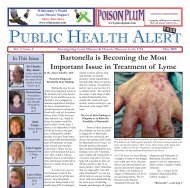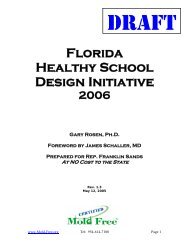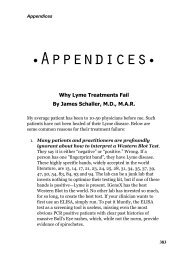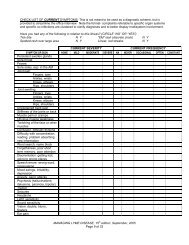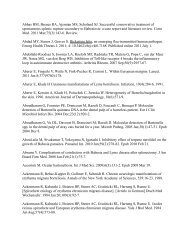Download Here - James L. Schaller, M.D., M.A.R., P.C
Download Here - James L. Schaller, M.D., M.A.R., P.C
Download Here - James L. Schaller, M.D., M.A.R., P.C
You also want an ePaper? Increase the reach of your titles
YUMPU automatically turns print PDFs into web optimized ePapers that Google loves.
Environmentally Friendly Mold Remediation Techniques That Significantly Reduce Childhood AsthmaThen replace the missing drywall with new. No drywall finishing isrequired as the new material will be behind the base board. Make sure youleave a 1/2 inch gap at the bottom of the drywall so the new drywall ishung off of a concrete floor and does not absorb moisture.Keep the base off of the floor so it does not continue to absorb water whenyou reattach the base.Make sure the bottom of the base has been painted with 2 coats of moldinhibiting paint.Non-porous materials. Examples include metal, ceramic tile,porcelain, glass, hard plastics, highly finished solid wood items, andother hard, smooth and non-permeable surfaces. Concrete and brickare considered semi-porous in certain situations. However, they areeasily cleaned using strong bleach and are included here under thetreatment of non-porous. Cleaning steps include surface vacuumingand bleaching or wiping with a detergent solution followed by disinfectant.9.6 Moisture ControlThe importance of addressing moisture in any effort to solve a moldproblem cannot be overstated. The presence of excess moisture is theunderlying cause of indoor mold growth. Identifying and correctingthe sources of excess moisture are vital to both resolving moldproblems and preventing their reoccurrence. Judging the completionof a remediation job should include evaluation of steps taken tocorrect moisture problems and prevent their return.If a water event occurs, it is critical to quickly correct the water sourceand to initiate restorative drying practices before mold growth occursor spreads. Wet materials should be dried rapidly in less than 48 hours– preferably in less than 24 hours – to a moisture content that doesnot support mold growth. Check that there is no visible mold growthbefore drying, since restorative moisture drying methods canpressurize materials (such as wall cavities) and allow mold particles (ifpresent) to spread to uncontaminated areas.Non-salvageable items that have been wetted or begin to showevidence of mold growth should be discarded promptly 1 . As a81





